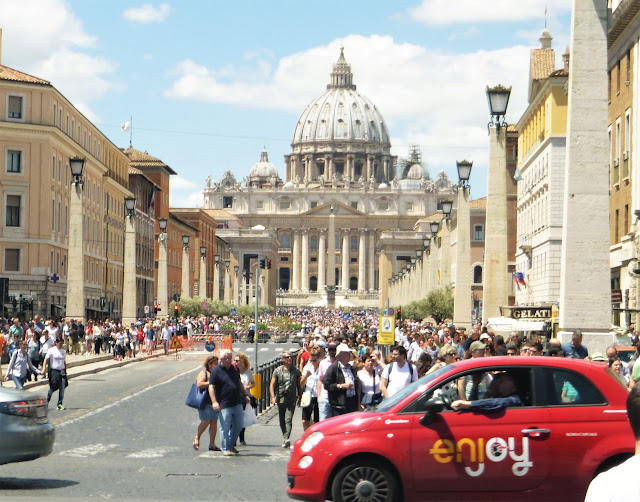You could do a pretty good one day "History in a Place" feature within a short stroll of this spot. This is looking across the Tiber river to Castel Sant' Angelo, which originally was the Mausoleum of Hadrian.
A view from on the bridge. It is by the way another Roman original, the Pons Aelius. It was built by Hadrian at the same time (AD 134 - 139) as the Mausoleum.
Hadrian and his wife Sabina were buried here, as in fact were subsequent Emperors at least as far as Caracalla in 217. It fell on hard times along with the late Empire, in 405 Honorius incorporated it into the "across the river" section of the city Walls. This did not prevent it from being sacked by Alaric's Goths five years later. It is said that they tossed out the urns and scattered the ashes. The Goths were a recurring problem of course, and Procopius records that in the Siege of 537 a surprise attack was repelled when the Roman defenders of this now fortress resorted to throwing the statues down off the roof!
Once a magnificent edifice it now has the look of what it spent most of its career being, a fortress.
In fact it was the refuge of last resort for the Pope when things got tough. Because St. Peter Square is right behind it.
That's as close as I felt like getting on a busy Sunday. But if you look at the exact center of the picture you will notice yet another obelisk.
This is the so called "Vaticano" obelisk and is noteworthy for being the only obelisk that has never fallen.
This obelisk is what I would consider Egyptian/Roman. That is it was made in Alexandria in the 1st Century BC but for the Romans. It was dedicated to Augustus. It is bare of hieroglyphics or other markings.
The open space you see in the above picture is in fact approximately where the Circus of Caligula once stood. That Emperor in fact brought the obelisk over to decorate the circus. (Later called the Circus of Nero). Although it has never fallen it has been moved a bit in the Middle Ages. One reason the obelisk was preserved is that it was the traditional place where St. Peter was martyred "inter duas metas" which is between the two turning points of the circus...where the central obelisk would have stood. The other legend, that the ashes of Julius Caesar himself were contained within a bronze ball at the top, has since been disproven.
By the way this is the other obelisk for which we have an ancient source regards its installation. None other than Pliny the Elder discussed its transport by a huge "obelisk ship" which was subsequently sunk to form part of the base of the light house at the port of Portus.



No comments:
Post a Comment